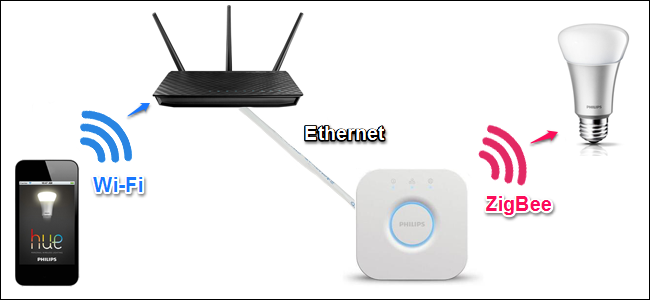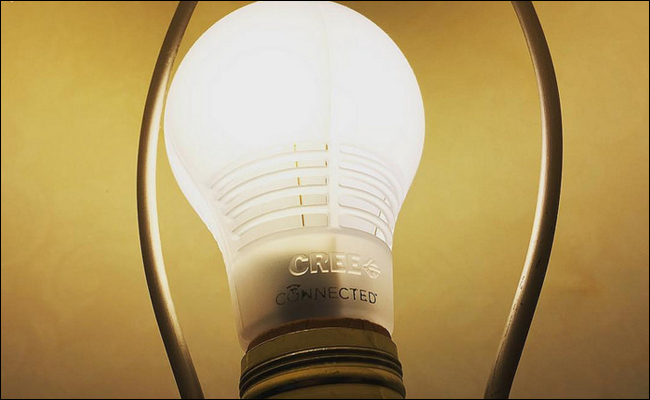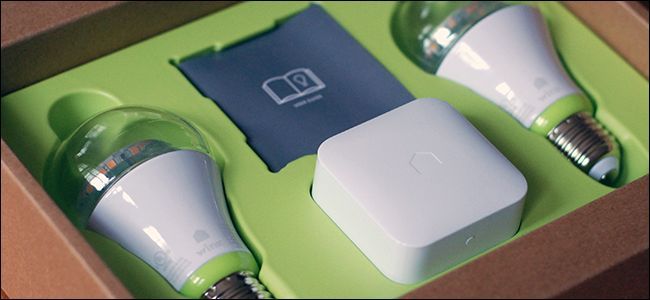Quick Links
As you research new smarthome products to put in your home of the future, you'll come across a lot of terms and categories that seem completely foreign. At the top of the list: "ZigBee" and "Z-Wave" products. What does this mean, and what's the difference between the two?
ZigBee and Z-Wave Are How Your Smarthome Gadgets Communicate with Their Hubs
ZigBee and Z-Wave are the two wireless protocols that pretty much all hub-based smarthome products use. There are a small handful of smarthome accessory makers that use their own standard (like Insteon, for instance), but ZigBee and Z-Wave are the two biggest open protocols out there.
Many smarthome products come with hubs, which are essentially middleman devices placed between your various smarthome accessories and your home's Wi-Fi. Contrary to what you may think, smart light bulbs (like Philips Hue, GE Link, Osram Lightify, etc.) don't connect directly to your Wi-Fi--instead, they connect to their hub using a protocol like ZigBee or Z-Wave, and then that hub is what communicates with your home network. Think of ZigBee and Z-Wave more like Bluetooth, but for smarthome products.
So why do smarthome products do this, instead of just using Wi-Fi for everything? First off, Wi-Fi is generally overkill for what most smarthome products need, and it also uses a lot more energy than ZigBee and Z-Wave. Furthermore, the hub won't interfere with your Wi-Fi and bog down an already-crowded network.
ZigBee and Z-Wave also use mesh networking, which means that every smarthome accessory can act as a signal repeater of sorts. For example, if you have Philips Hue lights set up in a large house, not every single bulb may be in range of the hub. If a bulb is too far away from the hub, it'll connect to a nearby bulb instead, which in turn connects to the hub. That's a useful feature to have if you have a bigger house.
Sure, you can extend your network using a Wi-Fi extender of some kind, but those don't extend the Wi-Fi signal at full strength, so there's the cost of performance loss when you do so. ZigBee and Z-Wave don't have this downside. It also means that the signals don't need to be incredibly powerful, which can improve battery life drastically for smarthome accessories that operate on battery, like door sensors.
Not every product uses a protocol like Zigbee and Z-Wave, of course. Some use plain ol' Wi-Fi, especially single products that don't have different accessories connecting to it. The Nest Thermostat, Amazon Echo, and some of Belkin's WeMo accessories all connect directly to Wi-Fi, for example. There's no hub to mess with, so they connect right to your network. Some products use Bluetooth, too, but it isn't quite as popular.
So basically, ZigBee and Z-Wave are the biggest standards that you'll run across, and any smartphone product with a hub probably uses ZigBee or Z-Wave to communicate with its devices.
ZigBee and Z-Wave Allow for Better Compatibility Across Products
So, since ZigBee and Z-Wave are standards in the smarthome world, does this mean that you can connect two ZigBee (or Z-Wave) products together with ease? Not necessarily...but in many cases, you can.
First of all, while both protocols are fairly similar, they don't work with each other, so you can't connect a ZigBee product to a Z-Wave product, unless the hub supports both ZigBee and Z-Wave (like the Wink hub). Furthermore, while they're both generic standards and fairly open, many manufacturers put their own proprietary twist on things, which can make it difficult to know if one ZigBee or Z-Wave product will connect to another, even if they use the same protocol.
For instance, Philips Hue uses ZigBee, but connecting third-party ZigBee-supported bulbs to the Hue's hub can be a chore, depending on what bulb it is. GE and Cree bulbs are fairly easy to connect, but Osram Lightify bulbs are sort of a pain to pair with the Hue's hub.
However, even if you can connect third-party bulbs to the Hue's hub, they may not take advantage of the mesh networking. For instance, GE Link bulbs won't pass on a signal to a Cree bulb, so the Cree bulb has to find another bulb to connect to if it's out of the hub's range.
Wink, on the other hand, has partnered with all sorts of companies to allow third-party accessories to connect to the Wink hub without needing individual hubs. So, you could connect a Lutron smart light switch to the Wink's hub without needing a Lutron hub.
If you're curious about whether or not a specific product will work with another third-party product, like connecting a third-party bulb to a Philips Hue hub or connecting third-party accessories to a SmartThings hub, you can usually check with the manufacturer and see if it's compatible. However, this chart provides a huge list of Z-Wave products and which hubs they'll work with. SmartThings also has its own compatibility list.
Keep in mind, though, that even if you connect third-party accessories to a third-party hub (like connecting Philips Hue bulbs to a SmartThings hub), this really only allows you to control the bulbs from within the SmartThings app---you'll still need to have the original Hue hub. This isn't the case for everything, but don't be surprised if you end up with a few hubs even after connecting everything together.
Purely Wi-Fi products, like the Nest Thermostat and Amazon Echo, can often work with ZigBee, Z-Wave, and other platforms too. But, it's dependent on whether or not the manufacturer adds support for these devices.
Open Protocols or Not, Smarthome Is Still Confusing
If you have just a few smarthome products set up in your house, it's probably not too complex, and everything makes sense. You might have a Nest Thermostat, Amazon Echo, Philips Hue, and a MyQ garage door opener. You might control them all from different apps, but overall it's not that confusing.
However, once you start to add more stuff to your smart house, confusion and chaos can set in. Don't worry: you're not alone. The whole smarthome field is very disjointed and confusing right now.
It's very difficult to consolidate all your smarthome gear into one simple interface using just one hub to control it all, and you'll experience all kinds of headaches if you try. This is the problem with having more than one smarthome protocol that companies can use.
Over time, it's possible that either ZigBee or Z-Wave will dominate the other, and smarthome products will morph into using just one standard to make it easier for anything to connect to anything and have it just work, but for the time being, it's still kind of a mess.
The best you can do is try to research every product you buy, and see what it's compatible with. There are services that make it easier for certain smarthome products to control another product that it may not support natively, too. IFTTT is a popular option, letting you do thinks like control your WeMo lights with an Amazon Echo, something that the Echo can't do natively. It's not the best solution by any means, but it's at least an option. Until things get a bit simpler, you'll have to just do your research--and be a little clever when things don't work out.
Images by Maximusnd/Bigstock, Michael Sheehan/Flickr




